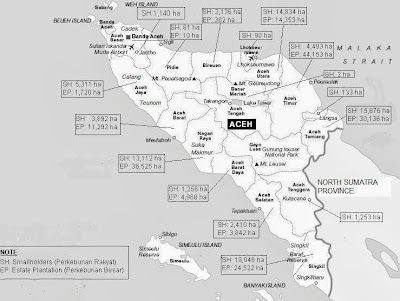Take a look at Aceh Timur.
Remember, this is a 2007 document. 6 years have
passed. In 2007 Aceh Timur had 44,000HA
of corporate plantations. This
is by far the largest area of any district in the province. The number is most certainly even higher now. There are only 4,000HA of palm oil trees in
Aceh Timur being farmed by their owners, and I am betting that these people are
not independent at all but who are now forced to rely on the actions and
decisions of the corporations in order to price, market and sell their product.
It seems such an uphill battle, to get our independent
cocoa farmers to think that a) their livelihoods are at all protected from
being subsumed by this different and frightening crop, b) they can band
together and form a coalition of independent farmers who can affect the cocoa
market in Aceh and strengthen their district’s economy, and c) this livelihood
will be so successful that their children will want to continue a tradition
that now seems hopeful, satisfying, and long-lasting.
But speaking of hopeful, our second training was an
enormous success, and I can’t wait to tell you about it.
Addendum: Aceh Timur’s Getting prettycrowded . . .
An
interesting article today. “Foreign
investors to build sugar factory in Central Aceh,” is notable for Central
Aceh’s being on the border of Aceh Timur, although the factory is in Ketol, in
the northwest part of the district. http://www.antara.co.id/en/news/90936/foreign-investors-to-build-sugar-factory-in-central-aceh
A
rather colorfully-translated 2013 blog post on the Japanese website ledadvertising.cocolog-nifty.com recently referenced a
lawsuit against Aceh Governor Irwandi for allowing a company to illegally take
1,600 HA of Tripa (west coast of Aceh) peat swamp for both mining and sugar
farming, which makes me think that sugar, like palm oil, is yet another crop in
Aceh competing with the rainforest. Central Aceh, as we can see, is a bit
closer to home.
The Antara News article also mentions that the
Vietnamese-owned factory will need 75HA for the factory and offices alone,
while “the company would need 12 hectares of farmland for sugarcane plantation
and the land has been available in Central Aceh.” A 12HA plantation with a 75HA factory? Methinks there is more HA lurking nearby that
they are not mentioning here.
The article also states that “the presence of PT
Kamadhenu is expected to encourage the local farmers to grow sugarcane.” Which is not a bad idea, in theory, since
sugar cane does not destroy the soil like palm oil trees do, and can be rotated
with other crops. The issue is that any
crop, if it’s planted where rainforest had been and is now being depleted, is
not sustainable for anyone.
We really have to be vigilant in this wild region of
Indonesia that’s been forgotten for so long, and whose forests and ecosystems
are disappearing and whose communities are growing poorer . . . it’s all
connected: the sugar cane, the mining, the palm oil. Even if I am only concentrating on Aceh Timur,
what is happening across the province affects everyone who must live and raise
their families here.



No comments :
Post a Comment